
2-Week Tour of Rome, Florence, Venice, & Italy's Scenic Countryside
 14 Day Tour of Rome, Florence and Venice
14 Day Tour of Rome, Florence and Venice
Overview
Trip Map
Itinerary
Inclusions
Reviews







14 Days 13 Nights
Best Time: Jan-Dec
Visiting Museums & Art Galleries
Exploring Scenic Countryside
Discover Italy in all its glory, including the ancient ruins of Rome, the Renaissance glories of Florence, and the serene waters of Venice. Delight in the charms of the Tuscan countryside, as you journey through rolling hills to Siena and San Gimignano. The trip is made easy with a private airport pickup, local guided explorations in Rome and Venice, and a half-day with a private driver in Tuscany. With detailed travel guidance every step of the way, your adventure to Italy's most iconic sights and off-the-beaten-path gems awaits.
- Gaze at the Sistine Chapel and the stunning architecture of St. Peter's Basilica in the Vatican City
- Feel history under your feet as you explore the Roman Forum and the Palatine Hill
- Sip Sangiovese in the Tuscan hills, as you visit UNESCO heritage sites brimming with life
- See the majestic Fountain of Neptune in Florence, a masterpiece adorning Piazza della Signoria
- Stroll around Piazza San Marco (St. Mark's Square) in Venice, the city of canals
- Get beyond the big cities on excursions to Siena, San Gimignano, and Verona
Discover Italy in all its glory, including the ancient ruins of Rome, the Renaissance glories of Florence, and the serene waters of Venice. Delight in the charms of the Tuscan countryside, as you journey through rolling hills to Siena and San Gimignano. The trip is made easy with a private airport pickup, local guided explorations in Rome and Venice, and a half-day with a private driver in Tuscany. With detailed travel guidance every step of the way, your adventure to Italy's most iconic sights and off-the-beaten-path gems awaits.
- Gaze at the Sistine Chapel and the stunning architecture of St. Peter's Basilica in the Vatican City
- Feel history under your feet as you explore the Roman Forum and the Palatine Hill
- Sip Sangiovese in the Tuscan hills, as you visit UNESCO heritage sites brimming with life
- See the majestic Fountain of Neptune in Florence, a masterpiece adorning Piazza della Signoria
- Stroll around Piazza San Marco (St. Mark's Square) in Venice, the city of canals
- Get beyond the big cities on excursions to Siena, San Gimignano, and Verona

Colosseum
Historic Landmarks

Vatican City
Churches & Monasteries

Piazza del Duomo
Churches & Monasteries

Uffizi Gallery
Museums & Galleries

Grand Canal
European History

Islands of Murano & Burano
Cultural
Must see sights

Colosseum
Historic Landmarks

Vatican City
Churches & Monasteries

Piazza del Duomo
Churches & Monasteries

Uffizi Gallery
Museums & Galleries

Grand Canal
European History

Islands of Murano & Burano
Cultural
Starting from
$3559
per person
 Not included
Not included Secure Your Customizable Trip
Enter your details to embark on a journey that can be tailored just for you.
Start
Travelers
Add Room
Remove Room
Preferred Hotel Stars
Craft Your Own Itinerary
Select your interests and destinations for a trip plan inspired by you.
Trip Map & Itinerary
Enable/Disable Map Scrolling

Click to See Map
Day-By-Day Itinerary
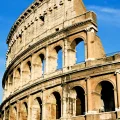
Day 1
Arrive Rome
View More
Day 1
Arrive Rome



To Be Determined
Private Transfer from Rome Fiumicino to Hotel
For your arrival in Rome, we will provide information on the customs and passport procedures. We will schedule a pick up for your flight's arrival time. You will be met at arrivals inside the terminal by a driver holding a sign with your name on it. The transfer is for your party only - you will not be sharing a vehicle. The cost of the ride will be included in your itinerary package and you will be taken directly to your hotel. IMPORTANT NOTE: Please be aware the car service can fit up to 1 checked item of luggage and 1 personal item per person, such as a purse or small backpack. If you think you will have more baggage, please inform your travel consultant as this may result in an additional fee.
Loading...

Day 1
Arrive Rome
View More


Day 1
Arrive Rome




To Be Determined:
Private Transfer to your Hotel
Mid-Day/Afternoon:
Colosseum
Late Afternoon/Early Evening:
Forum (Ancient Rome)

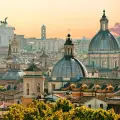
Day 2
Rome
View More
Day 2
Rome


9:00 AM - 12:00 PM
Grand Guided Walking Tour of the Historic Center
Get to know the historic core of Rome on this three hour private guided walking tour that takes in such famous sights as People's Square (Piazza Popolo), the Spanish Steps, Trevi Fountain where Anita Ekberg jumped into the water in Frederico Fellini's La Dolce Vita, the column of Marcus Aurelius, the Pantheon, and the most beautiful square in all of Italy - Piazza Navona.
Loading...

Day 2
Rome
View More



Day 3
Rome
View More
Day 3
Rome



Morning
Castel Sant'Angelo
Designed and built by Emperor Hadrian as his own mausoleum, the great circular hulk of Castel Sant'Angelo provides one of the best routes to the Vatican and St Peter's via the Ponte Sant'Angelo bridge. Appropriated by the popes, the mausoleum was turned into a fortress and attached to the Vatican with a passageway for the popes to use as a refuge in times of siege or invasion - this is where Pope Clement VII sheltered during the Sack of Rome in 1527.
Loading...

Day 3
Rome
View More



Day 4
Rome
View More
Day 4
Rome



Morning/Mid-Day
Visit Rome's Esquilino District
Upon first glance, this urban neighborhood of Rome may seem busy and overwhelming, but hidden among its traffic-noisy streets are some of Rome's most beautiful churches, artistic treasures, and cultural museums, including the Baths of Diocletian.
Loading...

Day 4
Rome
View More



Day 5
Rome to Florence
View More
Day 5
Rome to Florence




Morning/Mid-Day
Traveling the Via Appia on Foot or Bicycle
One of the earliest and strategically most important Roman roads of the ancient republic, the Via Appia (or Appian Way) once spanned 350 miles (563km), all the way from the Roman Forum in Rome to modern-day Brindisi. On the south side of Rome lies one of the best preserved stretches of the road, the Via Apia Antica. Take an afternoon to explore the ruins, catacombs, and sights along this infamously cobbled way. Exploring on foot is a relaxed and easy way to do it, made easier by the fact that bus stops along the way mean you don't have to backtrack. Bike rentals are also available and are a good way to cover as much ground as possible. But as an ancient cobbled road, sections of this walk are very bumpy, and depending on which route you take, you may encounter traffic. So you may want to consider if biking with a guided tour makes more sense.
Loading...

Day 5
Rome to Florence
View More



Day 6
Florence
View More
Day 6
Florence



Morning/Mid-Day
Visit Italy's Greatest Display of Art at the Uffizi Gallery
As the capital of the Renaissance, it's only fitting that Florence should also host Italy's greatest art gallery at the Uffizi. It's understandably busy throughout the year, but it's nevertheless worth the crowds to see to see some of the most sumptuous masterpieces of Renaissance art, including Botticelli's Primavera and Venus, and works by Michelangelo and Da Vinci. If you're planning to visit other galleries and museums in Florence, then it's definitely worth investing in a Firenze Card, which gives you free entry and priority access to 72 venues in the city. At a minimum, you should book ahead for the Uffizi to avoid very long queues.
Loading...

Day 6
Florence
View More


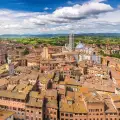
Day 7
Florence
View More
Day 7
Florence

Early Morning to Afternoon
Excursion to the Medieval Hilltop Town of Siena
For beauty and interest in Tuscany, only Siena comes close to Florence. Only an hour-and-a-half from Florence by train, it makes for a perfect day trip. The mesmerising brick-built medieval town with its narrow streets winding down into the valleys below was once a great regional power which rivaled Florence, and famously defeated the larger town in the legendary Battle of Montaperti. Its main square, the Campo, is one of the most satisfying urban spaces ever built, playing host to the annual Palio horse race in which each of the town's 17 contrade (i.e. city districts) participate. The traffic-free streets have been wonderfully preserved and its great Gothic buildings still exhibit the artistic masterpieces of the Sienese school of painting commissioned for them during the town's heyday in the 14th century.
Loading...

Day 7
Florence
View More



Day 8
Florence
View More
Day 8
Florence


Morning/Mid-Day
In the footsteps of the Medicis - Ponte Vecchio & Palazzo Pitti
The Ponte Vecchio, an iconic bridge over the Arno River, dates back to Roman times and is a key Florence landmark. Once home to butchers, it now houses jewelers and art dealers. The Vasari Corridor above was a Medici family passage linking the Palazzo Vecchio with the Pitti Palace, a treasure trove of Italian Renaissance and Baroque art by Raphael, Titian, and others. Walk across this magnificent bridge that connects the two sides of the city and learn about its history along the way.
Loading...

Day 8
Florence
View More


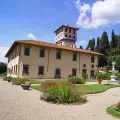
Day 9
Florence
View More
Day 9
Florence


Morning to Afternoon
Explore Renaissance Villas in the Nearby Hills of Florence
The Medicis and other powerful families of Renaissance Florence constructed magnificent country villas in the foothills surrounding the city and surrounded them with elaborate gardens populated with rose bushes, manicured hedgerows, and citrus trees. You can explore these beautiful villas which are concentrated in an area just a short bus ride from the city center of Florence. The villas served several functions, first and foremost as country palaces demonstrating power and wealth. They were also recreational resorts for the leisure and pleasure of their owners; and, more prosaically, they were the center of agricultural activities on the surrounding estates.
Loading...

Day 9
Florence
View More


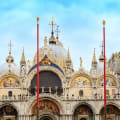
Day 10
Florence to Venice
View More
Day 10
Florence to Venice






9:20 AM
Transfer to Station by Taxi or Public Transport
Most trains depart from Firenza S.M.N. (i.e. Florence Santa Maria Novella Station) station, the largest station in the city. Before spending money on a transfer, be sure to check whether your hotel is within easy walking distance. Also consider that public transport is the cheapest and sometimes fastest option; trams and buses drop off next to the station. Uber is not available in Florence, but if staying at a hotel, they can order a reliable taxi. Some private transfers will even help with your bags.
Loading...

Day 10
Florence to Venice
View More



Day 11
Venice
View More
Day 11
Venice



Afternoon to Early Evening
St Mark's Square & Surroundings
St Mark's Square was the embodiment of The Most Serene Republic of Venice's power and prestige, and as such contains its most magnificent public buildings: the extraordinary golden mosaic-encrusted basilica of St Mark's, the exquisite Doge's Palace, the all-seeing bell tower, the Bibliotecca Marciana library, and what is nowadays the famous Correr Museum. If timed correctly, it is possible to see all these sights on your own within half a day, although a guide can make the process much more efficient (and more educational as well). Keep in mind that the square is one of the most heavily touristed places in the world, so crowds and lines can be an issue. St Mark the Evangelist was not the patrion saint of Venice until 829 AD, when two Venetian merchants stole St. Mark's remains from their original resting place in a chuch in Alexandria, Egypt, and then smuggled the relics home trussed up in a canvas sheet. The pretext for the theft was that the Muslim conquerors of Alexandria were expected to defile and plunder the church. While this may have been true, it is no coincidence that bringing such an important saint's relics to Venice was hugely important politically and signaled Venice's place as a rising independent power. A church was built to house the relics, and St. Mark's Square was established as the spiritual and political heart of the city.
Loading...

Day 11
Venice
View More



Day 12
Venice
View More
Day 12
Venice


Morning/Mid-Day
Rialto Bridge & San Polo District
The graceful arch of the Rialto Bridge is perhaps the single most iconic sight in Venice since nearly everyone passes beneath it on their journey along the Grand Canal. It connects Venice's two most visited districts, San Marco and San Polo. While San Marco is famous for St. Mark's Square, San Polo more than holds its own as a must-see destination, as it contains some of the city's oldest neighborhoods and most picturesque canals and bridges. It is also home to some of the best restaurants in Venice, and admittedly some of its worst tourist traps as well. Among many highlights is the bustling Rialto Market, which was once one of medieval Europe's busiest financial and trade markets, and still does a brisk trade in fresh seafood and produce.
Loading...

Day 12
Venice
View More


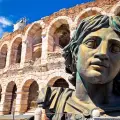
Day 13
Venice
View More
Day 13
Venice

Morning to Early Evening
Trip to Verona
Fair Verona, located just to the east of Lake Garda, is renowned for its beauty, its numerous buildings of immense artistic and historic value, and, of course, for its legendary story of Romeo and Juliet. There is more to Verona than just the Shakespearean tale, however. It is also home to one of the best preserved first-century amphitheaters in the world, as well as to a bustling historical center full of markets, boutique shops, and some fantastic eateries in which a stop for a taste of the regional wine is a must. Verona is an easy trip, as the fastest trains reach Verona in less than 75 minutes, and the historical heart of the city is only 1.2 miles (2 km) from the train station. There is a bus that connects the station to the central square, Piazza Brà. Verona's Old Town is surrounded by the River Adige on three sides, and many of its key attractions are located within a tightly-bound area of pedestrian-only streets. This makes exploring the city on foot very easy, which is a good thing since there is no public transport in the historical center.
Loading...

Day 13
Venice
View More



Day 14
Depart Venice
View More
Day 14
Depart Venice

To Be Determined
Transfer to Airport by Taxi or Water Bus
Most visitors will depart from the Venice Marco Polo Airport, which is located just across the water on the mainland. Because of the impossibility of driving inside Venice, you will need to take a water bus to Piazzale Roma on the edge of the city and then a land taxi to the airport (40 EUR), or take a water bus directly to the airport (15 EUR). It is also possible to take a private water taxi directly from your hotel to the airport, but it's very expensive. If you are departing from Venice Treviso Airport, you have much further to go. You can either take an expensive taxi ride (about 100 EUR) or take a shuttle bus for 12 EUR. The ATVO line departs from Piazzale Roma and takes 70 minutes, while the Barzi line picks up at the less convenient Tronchetto (the docks) but only takes 40 minutes.
Loading...

Day 14
Depart Venice
View More











Click to See Details
 Map of Your Itinerary Route
Map of Your Itinerary Route
Zoom In to the cities to see your itinerary in more detail

 4.8
4.8 